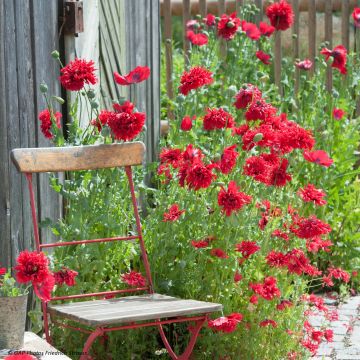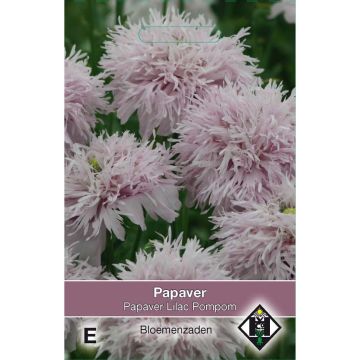

California Poppy Copper Swirl Seeds - Eschscholzia californica
California Poppy Copper Swirl Seeds - Eschscholzia californica
Eschscholzia californica Copper Swirl
California Poppy
30% success rate...
J-C V., 03/12/2020
Special offer!
Receive a €20 voucher for any order over €90 (excluding delivery costs, credit notes, and plastic-free options)!
1- Add your favorite plants to your cart.
2- Once you have reached €90, confirm your order (you can even choose the delivery date!).
3- As soon as your order is shipped, you will receive an email containing your voucher code, valid for 3 months (90 days).
Your voucher is unique and can only be used once, for any order with a minimum value of €20, excluding delivery costs.
Can be combined with other current offers, non-divisible and non-refundable.
Why not try an alternative variety in stock?
View all →This plant carries a 6 months recovery warranty
More information
We guarantee the quality of our plants for a full growing cycle, and will replace at our expense any plant that fails to recover under normal climatic and planting conditions.
Would this plant suit my garden?
Set up your Plantfit profile →
Description
California Poppy 'Copper Swirl' is a brand new variety of Eschscholtzia californica whose fiery coppery red-orange flowers will not go unnoticed, even under a blazing sun. Single or double, they display delicately crinkled petals which gleam with rich highlights in the sunlight. The spectacle of its dazzling blooms above its beautifully cut foliage lasts until the onset of colder weather. Just as at home in cloister-type gardens as in sophisticated flower beds, this plant withstands heat, drought and poor soils. It is moderately hardy but self-seeds easily in light soil.
California Poppy ‘Copper Swirl' is a variety obtained from Eschscholtzia californica, a short-lived perennial native to California and the Southwestern United States. There, this plant covers vast expanses of plains or very sunny, stony, wild meadows, not far from sequoia forests. Although it is not very resistant to heavy frost in wet soils, it is perfectly adapted to dry and hot climates and is easy to grow as an annual in all our regions. Like all poppies, it belongs to the Papaveraceae family.
This plant develops a taproot and quickly forms a clump of foliage, 25 cm in height and width. The leaves are pinnate, finely cut and of a particularly attractive colour varying between bluish green and green-grey, that enhances the colour of the flowers perfectly. Depending on when the seeds were sown, flowering takes place from spring to summer, lasting even up to November in Mediterranean climates. It reveals in the middle of its foliage, finely crinkled, cup-shaped flowers, that can are single or double depending on the specimen and that reflect the sunlight. They open up more in full sun. Their colouring is a hue between red and fiery orange. The flowers are melliferous and nectar-rich and are followed by the formation of long, tapering, 7 to 8 cm long, glaucous capsules that contain tiny seeds.
California poppies are a blessing for dry gardens, rock gardens, poor, difficult soils and seaside gardens. They can be sown in perennial beds, natural areas of the garden or even in pots. They are perfect plants for maintenance-free or weekend gardens. Their colours blend beautifully with white, light blue (false indigo, perennial flax, forget-me-not, Cupid’s Dart) and mauve (Wallflower 'Bowles's Mauve’, Purpletop Vervain). They are pretty but short-lived in bouquets.
Flowering
Foliage
Plant habit
Botanical data
Eschscholzia
californica
Copper Swirl
Papaveraceae
California Poppy
Cultivar or hybrid
Other Poppy seeds
View all →Planting and care
Sow the seeds of Eschcholtzia californica 'Copper Swirl' directly outside, from March to May or in September. The seeds will overwinter without harm. Plants sown in autumn, will flower in spring. Choose a very sunny spot in any poor, well-drained, loosened soil. Bury the seeds at a depth of 1 cm, in small holes spaced 15 cm apart. Cover the seeds so that they do not receive light. Water regularly to keep the soil moist, especially during dry periods. Germination usually takes 14 to 21 days. When the seedlings are large enough to be handled, space them 15 cm apart.
You can also sow California poppies indoors from February to March at a temperature of 15-21 °C.
When the seedlings are large enough to be handled, prick them out into pots and grow them in a cool place until the plants are large enough to be planted outdoors.
Cultivation:
These plants require full sun and perfectly drained, sandy or stony soil. The soil in which they grow must be poor. If the soil is too rich, the plant will produce only vegetative growth and become gigantic, eventually toppling over. In the garden, it contents itself with the most difficult situations as long as it is exposed to the sunlight: even in gravel, pebble-filled rockeries and dry slopes. It can be grown in pots and planters. These poppies do not like to be moved because of their taproot which is why it is best to sow them directly in their final locations.
Sowing period
Intended location
Planting & care advice
-
, onOrder confirmed
Reply from on Promesse de fleurs
Similar products
Haven't found what you were looking for?
Hardiness is the lowest winter temperature a plant can endure without suffering serious damage or even dying. However, hardiness is affected by location (a sheltered area, such as a patio), protection (winter cover) and soil type (hardiness is improved by well-drained soil).

Photo Sharing Terms & Conditions
In order to encourage gardeners to interact and share their experiences, Promesse de fleurs offers various media enabling content to be uploaded onto its Site - in particular via the ‘Photo sharing’ module.
The User agrees to refrain from:
- Posting any content that is illegal, prejudicial, insulting, racist, inciteful to hatred, revisionist, contrary to public decency, that infringes on privacy or on the privacy rights of third parties, in particular the publicity rights of persons and goods, intellectual property rights, or the right to privacy.
- Submitting content on behalf of a third party;
- Impersonate the identity of a third party and/or publish any personal information about a third party;
In general, the User undertakes to refrain from any unethical behaviour.
All Content (in particular text, comments, files, images, photos, videos, creative works, etc.), which may be subject to property or intellectual property rights, image or other private rights, shall remain the property of the User, subject to the limited rights granted by the terms of the licence granted by Promesse de fleurs as stated below. Users are at liberty to publish or not to publish such Content on the Site, notably via the ‘Photo Sharing’ facility, and accept that this Content shall be made public and freely accessible, notably on the Internet.
Users further acknowledge, undertake to have ,and guarantee that they hold all necessary rights and permissions to publish such material on the Site, in particular with regard to the legislation in force pertaining to any privacy, property, intellectual property, image, or contractual rights, or rights of any other nature. By publishing such Content on the Site, Users acknowledge accepting full liability as publishers of the Content within the meaning of the law, and grant Promesse de fleurs, free of charge, an inclusive, worldwide licence for the said Content for the entire duration of its publication, including all reproduction, representation, up/downloading, displaying, performing, transmission, and storage rights.
Users also grant permission for their name to be linked to the Content and accept that this link may not always be made available.
By engaging in posting material, Users consent to their Content becoming automatically accessible on the Internet, in particular on other sites and/or blogs and/or web pages of the Promesse de fleurs site, including in particular social pages and the Promesse de fleurs catalogue.
Users may secure the removal of entrusted content free of charge by issuing a simple request via our contact form.
The flowering period indicated on our website applies to countries and regions located in USDA zone 8 (France, the United Kingdom, Ireland, the Netherlands, etc.)
It will vary according to where you live:
- In zones 9 to 10 (Italy, Spain, Greece, etc.), flowering will occur about 2 to 4 weeks earlier.
- In zones 6 to 7 (Germany, Poland, Slovenia, and lower mountainous regions), flowering will be delayed by 2 to 3 weeks.
- In zone 5 (Central Europe, Scandinavia), blooming will be delayed by 3 to 5 weeks.
In temperate climates, pruning of spring-flowering shrubs (forsythia, spireas, etc.) should be done just after flowering.
Pruning of summer-flowering shrubs (Indian Lilac, Perovskia, etc.) can be done in winter or spring.
In cold regions as well as with frost-sensitive plants, avoid pruning too early when severe frosts may still occur.
The planting period indicated on our website applies to countries and regions located in USDA zone 8 (France, United Kingdom, Ireland, Netherlands).
It will vary according to where you live:
- In Mediterranean zones (Marseille, Madrid, Milan, etc.), autumn and winter are the best planting periods.
- In continental zones (Strasbourg, Munich, Vienna, etc.), delay planting by 2 to 3 weeks in spring and bring it forward by 2 to 4 weeks in autumn.
- In mountainous regions (the Alps, Pyrenees, Carpathians, etc.), it is best to plant in late spring (May-June) or late summer (August-September).
The harvesting period indicated on our website applies to countries and regions in USDA zone 8 (France, England, Ireland, the Netherlands).
In colder areas (Scandinavia, Poland, Austria...) fruit and vegetable harvests are likely to be delayed by 3-4 weeks.
In warmer areas (Italy, Spain, Greece, etc.), harvesting will probably take place earlier, depending on weather conditions.
The sowing periods indicated on our website apply to countries and regions within USDA Zone 8 (France, UK, Ireland, Netherlands).
In colder areas (Scandinavia, Poland, Austria...), delay any outdoor sowing by 3-4 weeks, or sow under glass.
In warmer climes (Italy, Spain, Greece, etc.), bring outdoor sowing forward by a few weeks.


































































